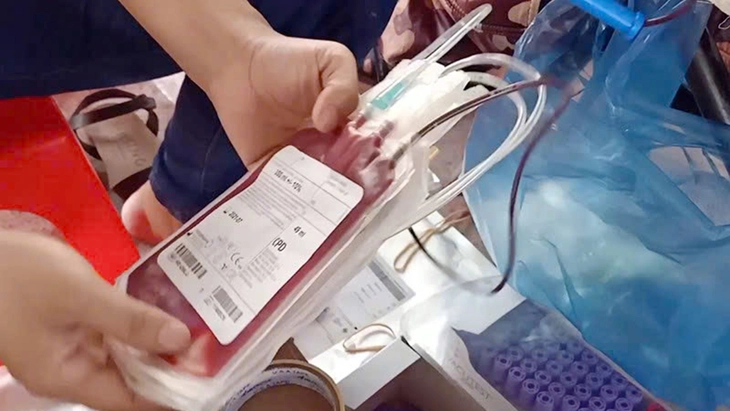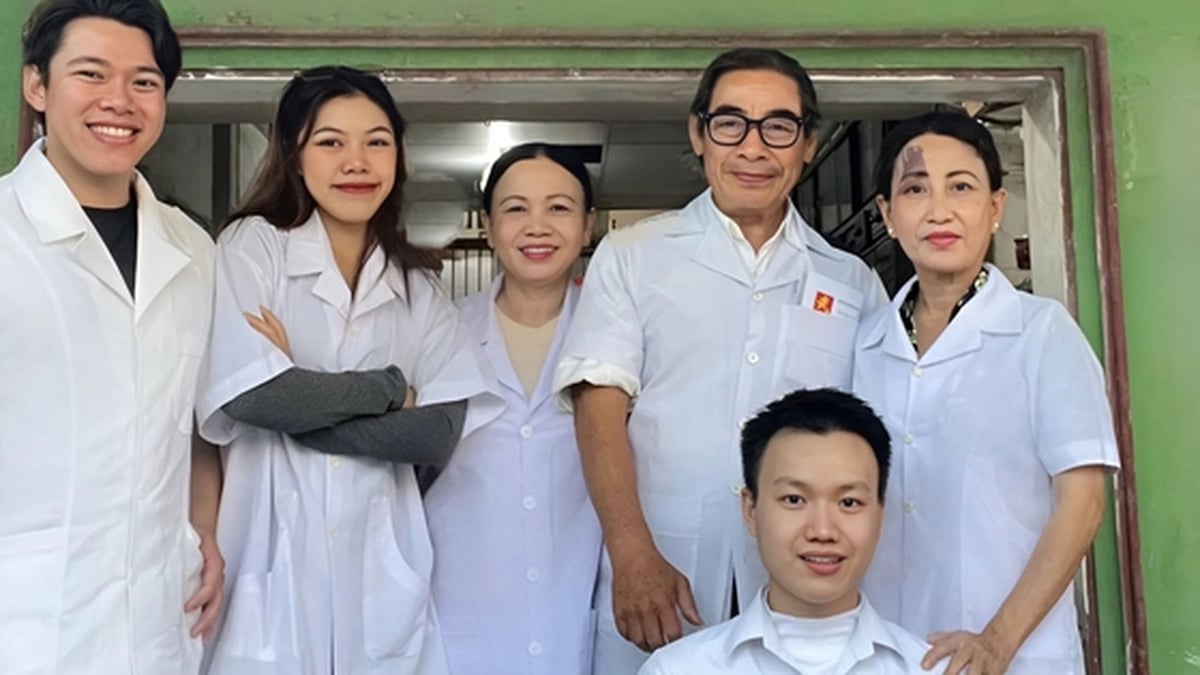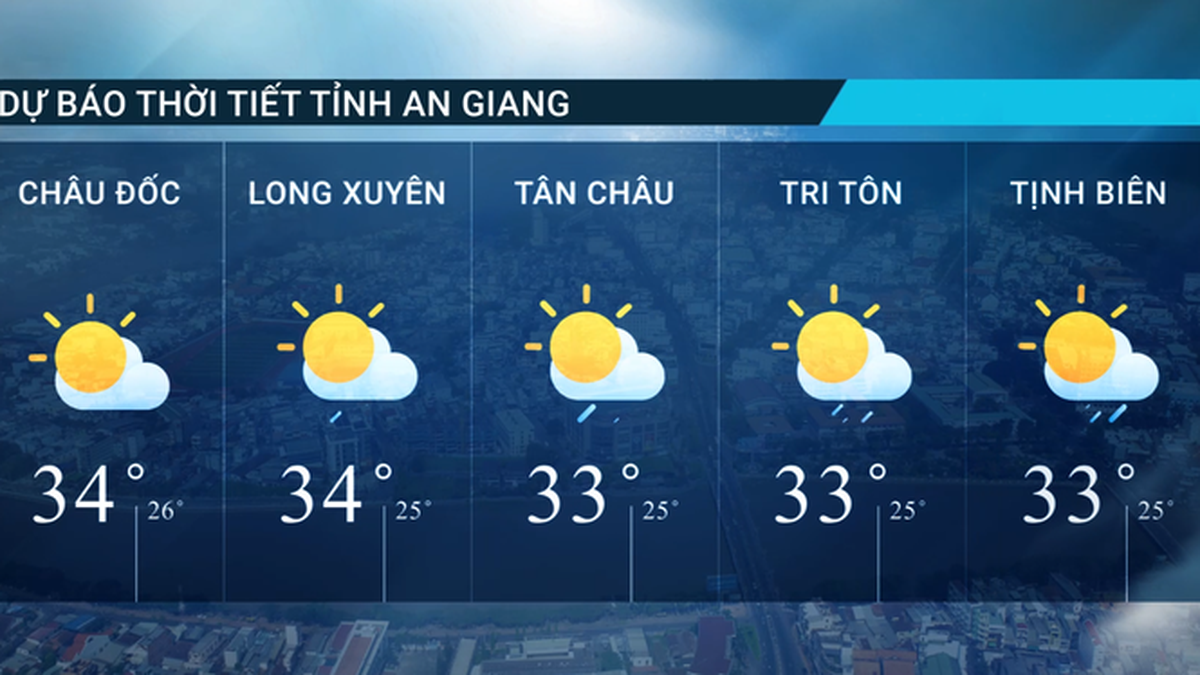Be careful when you have anemia - Photo: HA TUONG
Anemia is the most common syndrome globally, affecting approximately 1.92 billion people, or 24.8% of the world's population.
"In cases of acute anemia, the patient may suffer from hypovolemic shock, leading to damage to target organs. The patient may suffer from heart failure, kidney failure, respiratory failure..." - Dr. Nguyen Thi Thao, Deputy Head of the Department of Benign Blood Diseases, Central Institute of Hematology and Blood Transfusion, said.
Unexpected discovery of cancer due to... anemia
Ms. NTH, 45 years old ( Hanoi ) recently felt tired, had headaches, and had difficulty concentrating, so she went to see a doctor. After the blood test results, the doctor admitted her to the emergency room for a blood transfusion because of severe anemia: hemoglobin 45g/L. Luckily, she received timely emergency care, otherwise she could have had heart failure, stroke...
Another case is Ms. PTN, 62 years old ( Quang Ninh ) who suffered from seemingly "common" symptoms such as fatigue and dizziness due to anemia. When the patient went to the hospital and did in-depth tests to find the cause of anemia, she was diagnosed with stage 3 stomach cancer.
Doctors from the Department of Chemotherapy, Intervention and Palliative Care at the Vietnam - Sweden Uong Bi Hospital said that many patients are still negligent and subjective about the symptoms of dizziness and fatigue due to anemia. Anemic patients only think that simply supplementing nutrition is enough, and only go to the doctor when there is no improvement, at which point the condition has become very complicated.
According to statistics from the Department of Internal Medicine at Thu Duc City Hospital (HCMC), each month more than 50 new cases of anemia are recorded, mostly mild. Notably, among the cases, women aged 18-45 account for 50% - a number that reflects the general trend of the group susceptible to the disease in the world.
Dr. Bang Phuc Hau, Department of Internal Medicine, Thu Duc City Hospital, said: "The main cause of the increase in the disease is unscientific dieting habits, menorrhagia and gynecological problems in young women. Notably, the disease trend is also increasing in the post-COVID-19 group due to malabsorption and prolonged weakness."
Iron deficiency anemia often starts silently with nonspecific symptoms such as fatigue, dizziness, and difficulty concentrating. As the disease progresses, the patient may have pale skin, pale mucous membranes, brittle spoon-shaped nails, hair loss, rapid heartbeat, and shortness of breath on exertion. In particular, some cases also have pica syndrome - craving for strange things such as dirt and rocks.
Dr. Thao analyzed anemia as a condition of reduced hemoglobin in the patient's blood compared to people of the same sex, age and living conditions, causing symptoms of lack of oxygen in the body's tissues and organs. The level of hemoglobin reduction in the blood to 5% compared to the reference value (according to age, sex, living conditions) has diagnostic value to determine anemia.
Mild anemia: hemoglobin from 90 to 120g/L. Moderate anemia: hemoglobin from 60 to less than 90g/L. Severe anemia: hemoglobin from 30 to less than 60g/L. Very severe anemia: hemoglobin less than 30g/L.
Why anemia?
The cause of anemia is not only due to poor diet but also many other reasons. There are three groups of causes:
Blood loss: due to bleeding (patients with gastrointestinal bleeding, hemorrhoids, blood in urine, prolonged menstruation...).
Hemolysis: due to increased destruction of red blood cells due to causes in the red blood cells or other causes (congenital or immune hemolytic disease, malaria...).
Decreased or disordered blood production: due to decreased bone marrow production or disordered production of blood cells: bone marrow failure, myelodysplasia, malignant blood disease, metastatic cancer...
Or due to lack of hematopoietic factors such as erythropoietin, amino acids, folic acid and vitamin B12, iron deficiency...
According to Dr. Ho Xuan Truong - Department of Hematology, 108 Central Military Hospital, anemia is a syndrome found in many different internal and surgical diseases. Anemia can occur in cases of major trauma causing acute loss, a lot of blood such as vascular wounds, major bone fractures, traumatic brain injuries or in major surgeries such as open heart surgery, organ transplants... these patients often have obvious signs of acute blood loss requiring immediate blood transfusion.
Anemia can also occur in diseases that cause small, daily bleeding...
Anemia is often the first manifestation of malignant diseases such as leukemia, lymphoma, bone marrow metastasis and late stages of many other cancers.
Anemia complications make the patient feel tired, not strong enough to perform normal activities, dizzy and have difficulty concentrating. People with anemia often have chest pain, headaches or shortness of breath, pale skin.
In addition, anemia also increases the risk of other diseases.
Recognize the disease, treat it properly
Dr. Nguyen Quoc Thanh warns that anyone is at risk of anemia. Anemia is a condition in which the body does not have enough healthy red blood cells. Red blood cells have the role of transporting and supplying oxygen to tissues and organs in the body. Therefore, if you are anemic, your body does not receive enough oxygen to supply organs such as the heart, brain, lungs, etc.
When you have anemia, your heart has to pump more blood to compensate for the lack of oxygen in your blood. This can lead to heart failure and death...
The severity of the disease depends on the disease, the group of diseases that cause anemia such as bone marrow failure, iron deficiency anemia.
There are also sickle cell anemia, Thalassemia, vitamin B12 deficiency anemia, autoimmune hemolytic anemia...
Treatment options for anemia will depend on the cause and severity of the condition. People with mild anemia may not need treatment. Some common treatments for anemia include: medication, diet, blood transfusion, surgery, stem cell transplant...
Signs of anemia
Depending on the level of anemia, the patient will have symptoms such as:
- Fatigue, dizziness, lightheadedness, decreased concentration, loss of appetite; feeling of chest tightness, shortness of breath especially when exerting or moving a lot; feeling of nervousness, palpitations.
- Pale skin, pale mucous membranes; dry, brittle nails; dry, falling hair; amenorrhea in women.
HA TUONG
Source: https://tuoitre.vn/bat-ngo-phat-hien-ung-thu-khi-thieu-mau-20250608235540656.htm

































































































Comment (0)